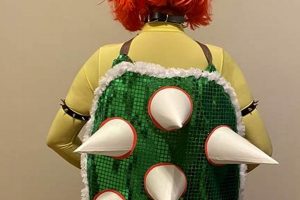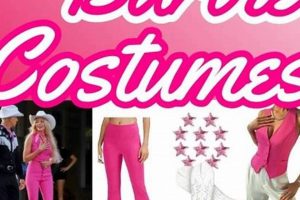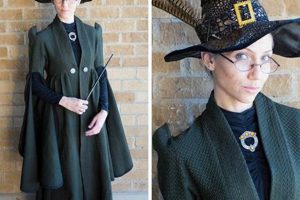Creating a jellyfish-themed outfit independently involves constructing a wearable representation of the marine animal using various materials and techniques. This process enables individuals to fashion a unique and personalized costume that mimics the distinctive features of a jellyfish, such as its bell-shaped body and trailing tentacles. An example includes utilizing an umbrella as the primary structure, attaching fabric strips to simulate tentacles, and incorporating lighting elements for visual effect.
The act of independently crafting a jellyfish costume offers multiple advantages. It fosters creativity and problem-solving skills as individuals devise innovative methods to replicate the jellyfish’s form. Furthermore, it provides a cost-effective alternative to purchasing pre-made costumes, often allowing for greater personalization and control over the final product. Historically, self-made costumes have been a popular choice for festive occasions, reflecting a desire for individuality and resourcefulness.
The subsequent sections will explore specific methods and materials suitable for constructing such a costume. Considerations will be given to factors such as safety, durability, and visual impact. These aspects will guide the reader through the process of designing and building a successful and visually appealing representation of this captivating sea creature.
Construction Pointers for a Self-Made Jellyfish Costume
The following guidelines offer practical advice to ensure a successful and visually compelling outcome when independently constructing a jellyfish-themed outfit.
Tip 1: Material Selection is Paramount: Opt for lightweight, translucent materials like tulle, organza, or plastic sheeting for the bell portion to emulate the jellyfish’s ethereal nature. Prioritize fire-retardant options for safety, especially if incorporating lighting elements.
Tip 2: Tentacle Design Requires Careful Planning: Experiment with various lengths, textures, and attachment methods for the tentacles. Consider using ribbon, yarn, bubble wrap strips, or plastic tubing filled with fiberfill. Varying the materials will create a more realistic and dynamic effect.
Tip 3: Illumination Enhances Visual Impact: Incorporate LED lights along the tentacles or within the bell for a striking visual. Battery-operated options are recommended for portability and safety. Ensure proper insulation and secure wiring to prevent hazards.
Tip 4: Structural Integrity is Essential: Reinforce the bell structure with a sturdy frame made of wire, plastic hoops, or repurposed materials. This will prevent the costume from collapsing and maintain its shape throughout wear.
Tip 5: Wearable Comfort Should Not Be Overlooked: Ensure that the costume is comfortable and allows for unrestricted movement. Designate appropriate armholes and head openings and avoid excessive weight. Conduct a test run to identify and address any potential discomfort.
Tip 6: Color Palette Selection Influences Realism: Emulate the vibrant colors of real jellyfish by incorporating iridescent or neon hues. Consider gradients and contrasting shades to add depth and visual interest. Research diverse jellyfish species for inspiration.
Tip 7: Attachment Security Guarantees Longevity: Utilize strong adhesives, stitching, or fastening systems to securely attach the tentacles and other embellishments to the bell. Reinforce weak points to prevent detachment during use.
By adhering to these recommendations, the individual can craft a visually impressive and structurally sound representation of a jellyfish. Careful planning and execution are crucial for maximizing the costume’s impact and durability.
The subsequent section will explore considerations of safety and regulations.
1. Material translucency
Material translucency is a critical factor in the independent creation of a jellyfish costume. The semi-transparent nature of jellyfish bodies is a defining characteristic, influencing the perception of the creature as delicate and ethereal. Consequently, selecting materials that mimic this translucency is essential for achieving a visually authentic representation. This selection directly impacts the realism of the costume; opaque materials will result in a less convincing portrayal. Tulle, organza, and certain types of plastic sheeting are commonly employed due to their ability to allow light to pass through, creating the desired effect. The cause and effect relationship is clear: increased translucency leads to a more believable jellyfish imitation.
The level of translucency also affects the effectiveness of any internal lighting elements used within the costume. Materials that are too opaque will block the light, negating the intended effect. Conversely, materials that are overly transparent might reveal the costume’s internal structure in an undesirable way. The optimal balance involves diffusing the light to create a soft, glowing effect, replicating the bioluminescence often observed in real jellyfish. For example, layering multiple sheets of semi-transparent fabric can achieve a gradient effect, enhancing the perceived depth and realism of the costume. This balancing act is essential for achieving the desired ethereal glow.
In summary, material translucency is a fundamental consideration in the design and construction of a jellyfish costume. Its appropriate application is instrumental in capturing the essence of these marine creatures. Challenges lie in finding materials that balance translucency with structural integrity and light diffusion. Understanding and addressing these aspects is key to creating a visually compelling and effective jellyfish costume. It ensures a realistic and engaging result.
2. Tentacle dynamism
Tentacle dynamism is a critical element in the independent construction of a jellyfish costume. The fluidity and movement of the jellyfish’s tentacles are defining characteristics, influencing the realism and visual impact of the costume. Statically positioned tentacles detract from the representation, rendering it less lifelike. Therefore, designs must prioritize movement to effectively mimic a jellyfish. The cause-and-effect relationship is evident: greater tentacle dynamism results in a more convincing and captivating jellyfish imitation.
Achieving tentacle dynamism necessitates careful consideration of material selection, attachment methods, and construction techniques. Lightweight materials such as ribbon, fabric strips, or plastic tubing allow for greater movement. Strategic attachment points and flexible connections facilitate natural swaying motions. For example, using varying tentacle lengths and weights creates asynchronous movement, mimicking the unpredictable nature of real jellyfish. The incorporation of internal wiring or articulated joints can further enhance dynamism, enabling controlled moveme
nts and visual effects. These features increase the level of realism.
In summary, tentacle dynamism is a fundamental consideration in independently constructing a jellyfish costume. Its successful implementation is essential for capturing the essence of these marine creatures. Challenges lie in balancing the need for movement with structural integrity and costume weight. Addressing these aspects is key to creating a visually compelling and authentic jellyfish costume. It contributes to the overall impression of realism and effectively distinguishes the costume from a static representation.
3. Illumination safety
Independent construction of jellyfish costumes often incorporates illumination to enhance visual appeal, directly linking to safety considerations. The integration of lighting elements, while aesthetically advantageous, introduces potential hazards that demand careful mitigation. Electrical shorts, overheating, and improper battery handling represent significant risks to the wearer and surrounding environment. For instance, improperly insulated wiring can lead to electrical shocks, while overheating LEDs can ignite flammable costume materials. Therefore, illumination safety is not merely an ancillary concern but a fundamental component of the independent jellyfish costume construction process. Failure to address these hazards can result in serious injury or property damage.
Practical application of illumination safety principles involves several key measures. The use of low-voltage, battery-operated LED lights minimizes the risk of electrical shock. Proper insulation of all wiring and connections prevents short circuits and potential overheating. Fire-retardant materials reduce the likelihood of ignition in the event of a malfunction. For example, encasing LED strips in heat-resistant tubing and securing battery packs in ventilated compartments minimizes potential hazards. Furthermore, rigorous testing of the illumination system before wearing the costume allows for early detection and correction of any safety deficiencies. Adherence to established electrical safety guidelines is paramount.
In summary, the integration of illumination in independently constructed jellyfish costumes necessitates a comprehensive approach to safety. The selection of appropriate materials, adherence to safe wiring practices, and thorough testing protocols are essential for mitigating potential hazards. The challenges associated with illumination safety underscore the importance of prioritizing risk assessment and implementing preventive measures. Ultimately, prioritizing safety ensures that the costume enhances enjoyment without compromising the wearer’s well-being or posing a risk to others. This focus ensures a visually stunning and safe final product.
4. Frame robustness
Frame robustness is intrinsically linked to the successful independent creation of a jellyfish costume. The structural integrity of the frame directly dictates the costume’s shape, stability, and overall wearability. A weak or poorly constructed frame will result in a deformed or collapsing costume, negating the intended visual effect and potentially rendering it unusable. The effect of frame instability undermines the costume’s impact, while adequate robustness upholds its aesthetic and functional characteristics. For example, utilizing thin wire or flimsy plastic as the primary support structure for a large, heavily decorated jellyfish bell would likely lead to sagging and distortion. In contrast, a reinforced frame constructed from sturdy wire hoops or a repurposed umbrella provides the necessary support to maintain the costume’s intended form.
The practical implications of frame robustness extend beyond mere aesthetics. A robust frame ensures the secure attachment of other costume elements, such as tentacles and lighting. It also distributes the weight of these elements evenly, preventing stress points and potential failures. Furthermore, a well-constructed frame enhances the wearer’s comfort and mobility, allowing for unrestricted movement and preventing chafing or discomfort. For instance, a frame that incorporates padded shoulder straps or a secure harness system will distribute the costume’s weight evenly, reducing strain on the wearer’s neck and back. Conversely, a poorly designed frame may concentrate the weight on a single point, leading to discomfort and fatigue.
In summary, frame robustness represents a fundamental consideration in the independent design and construction of jellyfish costumes. Its impact extends beyond mere structural integrity, influencing the costume’s overall appearance, wearability, and durability. Challenges associated with frame construction often involve balancing the need for strength and stability with the desire for lightweight and flexible materials. Addressing these challenges requires careful planning, material selection, and construction techniques, ultimately ensuring the successful creation of a visually appealing and structurally sound jellyfish costume. This guarantees the achievement of intended costume attributes, namely aesthetics, endurance and safety.
5. Wearer comfort
The independent construction of a jellyfish costume directly necessitates prioritizing wearer comfort. The success of a homemade costume extends beyond visual appeal; its wearability significantly impacts the user’s experience. Discomfort stemming from ill-fitting components, excessive weight, or restricted movement negates the intended enjoyment. The effect of discomfort detracts from the costume’s function, rendering it cumbersome and ultimately unsatisfying. For example, a costume featuring a rigid, close-fitting bell structure restricts arm movement and breathing, hindering participation in activities. Conversely, a design incorporating adjustable straps, breathable fabrics, and ample room for maneuvering fosters a positive user experience and allows for extended wear.
Practical considerations for wearer comfort encompass several design elements. Selecting lightweight materials reduces the overall burden. Incorporating adjustable straps and closures ensures a secure yet flexible fit. Ample ventilation prevents overheating and discomfort. Padding or cushioning minimizes friction and chafing. For example, employing soft, breathable fabrics like cotton for the interior lining enhances comfort against the skin. Strategically placed openings for arms and legs allow for unrestricted movement. These features require forward planning and testing for optimal achievement. These practical adjustments ensure ease of wear.
In summary, prioritizing wearer comfort represents a crucial aspect of successfully creating a jellyfish costume independently. The balance between visual aesthetics and ergonomic design determines the costume’s overall effectiveness. Challenges in achieving this balance often involve reconciling complex structural requirements with the need for lightweight and breathable materials. Addressing these challenges requires a meticulous approach to design, fabrication, and fitting, ultimately ensuring a comfortable, visually appealing, and enjoyable costume experience. The level of achievement for both visual appearance and wearer experience dictates the project success and guarantees wearer satisfaction.
6. Color selection
Color selection represents a critical design element within the realm of independently constructed jellyfish costumes. The deliberate use of color significantly influences the realism, visual impact, and overall aesthetic appeal of the final product. Careful consideration of color theory and the natural coloration of jellyfish species is essential for achieving a convincing and visually striking representation.
- Emulating Natural Coloration
Jellyfish exhibit a diverse range of colors, from transparent and translucent shades to vibrant and iridescent hues. Mimicking these natural colors enhances the realism of a homemade costume. For example, using pale blues, greens, and purples for the bell structure and incorporating iridescent materials for the tentacles can effectively replicate the shimmering effect observed in many jellyfish species. Conversely, deviating significantly from natural colors may result in a less convincing portrayal, unless a deliberately stylized or fantastical aesthetic is intended.
- Creating Visual Interest and Depth
Strategic color gradients and contrasting shades add depth and visual interest to a jellyfish costume. Employing a gradient from a darker shade at the top of the bell to a lighter shade at the bottom can create the illusion of three-dimensionality. Similarly, using contrasting colors for the bell and tentacles draws attention to these distinct features and enhances visual impact. For example, pairing a translucent blue bell with vibrant pink or purple tentacles creates a striking and memorable effect. The deliberate manipulation of color effectively elevates the costume’s visual complexity.
- Communicating Specific Species or Themes
Color selection can be used to evoke specific jellyfish species or thematic concepts. For instance, a costume predominantly featuring deep blues and blacks might represent a deep-sea jellyfish, while a costume incorporating bright yellows and oranges could evoke a tropical species. Furthermore, color can be used to convey specific themes, such as bioluminescence or toxicity. A costume incorporating neon colors and reflective materials could represent a bioluminescent jellyfish, while a costume featuring warning colors like red and yellow might imply toxicity. The deliberate use of color can inject additional narrative and conceptual depth into the costume’s design.
- Impact on Illumination Effects
The chosen color palette significantly interacts with incorporated lighting elements. Light colors transmit illumination more readily than dark colors, while certain hues interact with specific light frequencies, enhancing particular effects. For example, using a blue-tinted transparent material paired with blue LED lighting accentuates the costume’s underwater aesthetic. Conversely, dark or opaque materials dampen illumination, diminishing the light’s effect. Proper integration ensures that color complements and enhances the costume’s luminosity.
In conclusion, the selection of colors plays a vital role in independently constructing a jellyfish costume. By carefully considering natural coloration, visual interest, thematic representation, and the impact on lighting effects, the designer can create a visually compelling and aesthetically pleasing representation of these captivating marine creatures. The deliberate application of color elevates the costume from a simple garment to an artistic expression.
Frequently Asked Questions
This section addresses common inquiries and concerns regarding the independent construction of jellyfish costumes. It aims to provide informative answers that assist individuals in creating safe, visually appealing, and structurally sound representations of these marine creatures.
Question 1: What are the most suitable materials for creating a translucent jellyfish bell?
Optimal material choices for the bell component include tulle, organza, and thin plastic sheeting. These materials offer varying degrees of translucency, allowing light to permeate the structure and emulate the ethereal appearance of a jellyfish. Material selection should consider durability, weight, and compatibility with intended decorative elements.
Question 2: How can dynamic tentacle movement be achieved in a homemade jellyfish costume?
Dynamic tentacle movement requires careful consideration of material, length, and attachment. Lightweight materials such as ribbon, fabric strips, or thin plastic tubing respond readily to movement. Varying tentacle lengths and strategically attaching them at multiple points around the bell perimeter enhance the natural swaying motion. Internal wiring and articulated joints represent advanced techniques for controlled movement.
Question 3: What safety precautions should be observed when incorporating illumination into a jellyfish costume?
Illumination safety is paramount. Utilize low-voltage, battery-operated LED lights to minimize electrical hazards. Ensure proper insulation of all wiring and connections to prevent short circuits and overheating. Employ fire-retardant materials in the costume’s construction to mitigate fire risks. Conduct thorough testing before wearing the costume to identify and rectify any potential hazards.
Question 4: How can the structural integrity of a jellyfish costume frame be ensured?
A robust frame provides essential support and maintains the costume’s shape. Employ sturdy materials such as wire hoops, plastic tubing, or repurposed umbrella frames. Reinforce critical joints and attachment points with strong adhesives or fasteners. Distribute the weight of decorative elements evenly across the frame to prevent stress and distortion.
Question 5: What measures can be taken to enhance wearer comfort in a jellyfish costume?
Wearer comfort is crucial for a positive experience. Select lightweight and breathable materials. Incorporate adjustable straps and closures to ensure a secure and comfortable fit. Provide ample ventilation to prevent overheating. Pad areas of potential friction or chafing with soft materials.
Question 6: How does color selection influence the overall aesthetic of a jellyfish costume?
Color selection significantly impacts the realism and visual appeal of the costume. Consider the natural coloration of jellyfish species when choosing materials. Employ color gradients and contrasting shades to create depth and visual interest. Integrate color strategically to evoke specific themes or species. A cohesive color scheme is essential for a visually impactful design.
These answers provide a foundational understanding of key considerations when independently constructing jellyfish costumes. Prioritizing safety, structural integrity, and wearer comfort ensures a successful and enjoyable creative endeavor.
The subsequent section will delve into advanced techniques and embellishments for jellyfish costume design.
jelly fish costume diy
The preceding examination has elucidated critical aspects of independently creating jellyfish costumes. Material translucency, tentacle dynamism, illumination safety, frame robustness, wearer comfort, and color selection are paramount considerations. Adherence to these guidelines ensures a final product that is both visually compelling and structurally sound. This process is a complex synthesis of artistic vision and practical execution.
Mastery of independent costume creation necessita
tes ongoing refinement of technical skills and a commitment to continuous learning. The principles outlined herein serve as a foundation for future explorations in creative expression and design innovation. The successful application of these concepts results in both artistic satisfaction and a deeper understanding of design principles.







